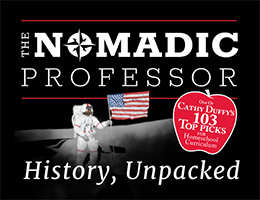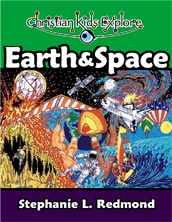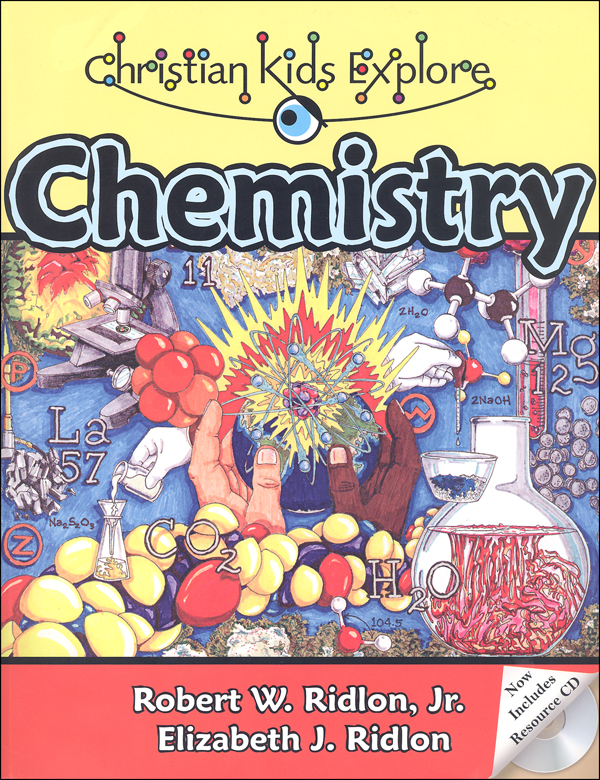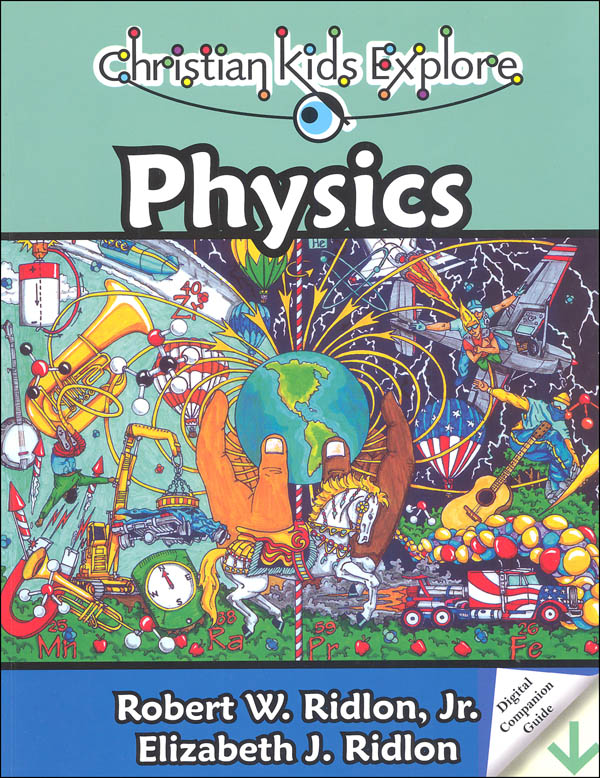I like the balance of information and activity in the Christian Kids Explore science series. Rather than books for specific grade levels, this series has five books that can be used with children spanning at least four grade levels.
All five books are divided into a number of units, with multiple lessons per unit. Lessons are ideal for use in two 90-minute block sessions a week rather than shorter, more-frequent classes. This gives children enough time to get into the activities and think about the concepts. Working on this schedule, you should be able to complete one book per year.
While parents or teachers will need to do some lesson preparation, it is minimal for the first two books and very manageable for the rest. Lessons are laid out so clearly that these courses should be very easy to use. There are numerous activity pages within each book that you are welcome to reproduce or print for your family from either CD-ROMs or downloadable files. Students should each maintain a three-ring binder in which they keep all of their science work.
At the back of each book are answer keys plus lengthy lists of recommended resource such as books, DVDs, computer games, and kits that you might use to supplement your studies or challenge older students. You don’t have to use other resource books, but each study will be much richer for students if you use some of the colorful picture books available on the different science topics. Since the Christian Kids Explore books are printed only in black-and-white, this might be especially important for some learners.
All of these courses include learning activities that help meet the needs of different learning styles—hands-on activities for wiggly children, interaction for the sociable child, predictable vocabulary study and testing for those who like structure and consistency, and independent reading for those who prefer to work on their own.
Christian Kids Explore Earth and Space and Christian Kids Explore Biology
Christian Kids Explore Earth and Space and Christian Kids Explore Biology, both written by Stephanie L. Redmond, are very similar in design to one another. Both books target grades three through six but can be used selectively with children as young as kindergarten—especially the hands-on activities. They seem particularly good for third and fourth grade levels. However, Biology is slightly more challenging than Earth and Space. While two ninety-minute sessions per week are best, you can break lessons down into more frequent lessons for students with shorter attention spans.
Biology has an optional downloadable student activity book for $7.95 with only the reproducible student pages from the textbook. You can purchase and print these for additional students. These pages include Review-its, activity and experiment forms, unit review activities and quizzes, and coloring pages. These are duplicates of pages in the text rather than additional material.
The second edition of Earth and Space includes a CD-ROM in the back of the book that has printable lesson plans, all of the reproducible student pages (Review-its, activity and experiment forms, unit review activities and quizzes, and coloring pages), materials lists, and a bonus literature study guide for a science-related biography. Literature study guides (available for all courses except Biology) offer substantial activities—written work, discussions, and hands-on activities—but they are an optional part of each course. The literature study guide for Earth and Space is for The Big Wave by Pearl S. Buck.
The first session each week is “teaching time.” It begins with reading and discussing the information from the text. Students complete a Daily Reading Sheet, write words and definitions for their vocabulary list in a notebook, and possibly work with flashcards. Younger students might do less writing, and older students need to do extended reading or research from real books and other resources from the lists provided at the back of each book.
The second session is “hands-on time” for experiments or activities. These don’t require expensive or exotic materials, but it will take a little work to gather the necessary items. For example, Earth and Space requires items like clay, a funnel, sun-sensitive paper, an atlas, a globe, vinegar, baking soda, chewing gum, and a paper plate. For Biology, among resources you need are pipe cleaners, a magnifying glass, old T-shirts, face paints, and alligator stickers.
There are also some artistically-created coloring pages—one per unit. Colored pencils are the perfect medium to use for these. The book also has numerous black line illustrations that children might color.
Vocabulary words, timeline entry items, and lists of materials needed are at the beginning of each unit. Each unit concludes with a quiz. Biology also includes a writing assignment at the end of each unit while Earth and Space suggests either a writing assignment or creation of a “folderbook” (directions in an appendix).
Other reproducible pages in the appendices include a Field Trip Journal form, Checking it Out experiment form, Write About It! worksheet for a unit composition, maps, scripture memory cards, recipes, supplemental activities such as word searches, and numerous other worksheets pertaining to the lessons.
A biblical worldview is presented throughout both books and is reinforced by scripture memory cards. Unit 2, lesson 3 of Earth and Space advances a creationist, young-Earth perspective, although it does present the broader context of scientific disagreement as well as disagreement among Christians. Most recommended resources for the lessons are secular and present alternative explanations. In Biology, the first lesson advances a creationist perspective, although it takes no position on the age of the earth. However, recommended resource books tend toward a young earth position.
Christian Kids Explore Chemistry, Physics, and Creation Science
The next three books in the series are similar to each other, differing in format from the first two books. Christian Kids Explore Chemistry, Christian Kids Explore Physics, and Christian Kids Explore Creation Science were written by Robert W. Ridlon, Jr. and Elizabeth J. Ridlon. They are recommended for students in grades four through eight. The level of content in Chemistry and Physics is more advanced than in the first two books. Creation Science starts out at a very easy level, but the second half moves into significantly more difficult material. There are far fewer reproducible student activity pages, and the coloring pages for Chemistry and Physics are limited to a smaller selection in an appendix at the back of each book. Creation Science has many coloring pages.
Christian Kids Explore Chemistry is more than a simple introduction to chemistry. In 356 pages, the authors cover the basics of chemistry, including some topics often reserved for high school courses. But they do so in a way that is very understandable for younger students. They use a conversational style and familiar examples to which children can relate. While you might occasionally find topics like “covalent bonds” that are beyond your fourth or fifth grader, most of the presentation is so clear and concrete in the way it is taught that most students will understand and enjoy the lessons. You might even use this if you’ve got a high schooler who struggles with the math involved in chemistry.
The book begins with lessons on matter, measurement, elements, mixtures, compounds, atoms, molecules, the periodic table, mass, and atomic number. Then it advances into chemical bonds, formulas, names of compounds, acids, bases, and chemical reactions. The next section deals with states of matter, and the final section gets into organic chemistry.
While older students might read the lessons directly from the book on their own, you will want to read the lessons to younger students, perhaps paraphrasing or skipping difficult sections as needed.
Following the lesson information is a Review-it section with fill-in-the-blank questions that depend only upon listening and comprehension at this point. You should photocopy or print out these pages as well as those for unit reviews, worksheets, and coloring pages.
“Think About It” questions that come next in most lessons might be used as follow-up for a hands-on activity, or they might require written work or discussion. These challenge students to understand and apply some creative thought to the lessons. Each unit concludes with a test.
At the beginning of each unit you will find a list of objectives, vocabulary words, and materials needed for all activities for the unit. Materials are mostly common household items, with the exception of things like Styrofoam® balls, Alka Seltzer®, and safety glasses for Chemistry; and a stopwatch, various types of balls, and a horseshoe magnet for Physics.
Hands-on activities are used to reinforce or help teach each lesson. These are frequently experiments, but sometimes they are things like building models of molecules, creating cards for elements of the periodic table, completing observation forms, doing word searches, or coloring pages.
The second editions of both Chemistry and Physics each include a CD-ROM in the back of the book similar to that described for the Earth and Space course. Those with earlier editions of Chemistry or Physics can purchase a downloadable file with the content on the CD-ROMs that are now packaged with new editions of the books ($9.95 per course).
The CD-ROM for Chemistry includes a literature study guide for Joyce McPherson's biography of Blaise Pascal, A Piece of the Mountain. While the rest of the study has minimal Christian content, this book centers around the spiritual life of this great thinker.
Christian Kids Explore Physics has 405 pages divided into six units on physics, matter, mechanics, matter in motion, energy in motion, and electricity and magnetism.
The relatively simple activities and experiments should be appealing, although some of the math (used in only a few activities) will be challenging for younger students. Examples of the activities include creating atomic models, observing balloon expansion and contraction in various temperature settings, plotting trajectories for a tennis ball rolling off a table, calculating bicycle wheel speed, and creating a compass. Simple household items are used for most of these. The optional literature study for Physics is based on the book Ben Franklin of Old Philadelphia by Margaret Cousins. This study takes a secular approach.
Although Chemistry and Physics are intended for a Christian audience and have occasional scripture verses in the sidebars, I found only scattered references to God. Those references were so generic that the books should be fine for any family who shares a belief in God as Creator. It would be very easy for parents or teachers with other beliefs to use these books with minimal adaptation.
Christian Kids Explore Creation Science differs drastically in this regard. It has significant religious content, advancing belief in a literal interpretation of Genesis 1 and belief in a young earth.
In the first part, it teaches the creation model, six days of creation, and Noah's flood and its importance to the creation model. The second part, "Advanced Topics in Creation Science," are more challenging. Here the book addresses methods of dating and the age of the earth, the evolution model, problems with the evolution model, and other topics that defend the creationist model.
The argumentation and evidence presented is often superficial. This might be appropriate for young students, but it certainly isn't for older students. So I am less enthused about this book than I am about the others in the series.
Christian Kids Explore Creation Science comes with a CD-ROM like the other courses. It features a literature study guide for Ruth Beechick's book, Adam and His Kin.
Summary
The Christian Kids Explore series is a good option for homeschooling families who want to teach children of various ages together. It makes it easy to provide interesting science education with hands-on activities.















